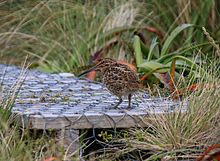Austral snipe
| Austral snipes | |
|---|---|

| |
| Campbell snipe | |
| Scientific classification | |
| Domain: | Eukaryota |
| Kingdom: | Animalia |
| Phylum: | Chordata |
| Class: | Aves |
| Order: | Charadriiformes |
| Family: | Scolopacidae |
| Genus: | Coenocorypha G.R. Gray, 1855 |
| Type species | |
| Gallinago aucklandica[1] G.R. Gray, 1845
| |
| Species | |
|
see text | |
The austral snipes, also known as the New Zealand snipes or tutukiwi,
Taxonomy and range
The relationship between Coenocorypha snipe and the
and Campbell Island.A morphological study and comparisons of
In 1997, a previously unknown form of snipe was discovered on Jacquemart Island off Campbell Island.[5] The Campbell snipe was described as another subspecies in the radiation of New Zealand snipes.[6] Fossil remains of Coenocorypha have also now been discovered on the islands of New Caledonia, Fiji and Norfolk Island.[7][8] Fossil evidence has also shown that the Little Barrier Island form was once widespread across North Island and the Stewart Island form across South Island; both are now extinct.
Species and subspecies
- Chatham snipe C. pusilla (Buller, 1869) – Chatham Islands
- Subantarctic snipe C. aucklandica (G.R.Gray, 1845)
- Auckland snipe C. a. aucklandica (G.R.Gray, 1845) – Auckland Islands
- Antipodes snipe C. a. meinertzhagenae Rothschild, 1927 – Antipodes Islands
- Campbell snipe C. a. perseverance Miskelly & Baker, 2010 – Campbell Island
- Snares snipe C. huegeli (Tristram, 1893) – Snares Islands
- † North Island snipe C. barrierensis Oliver, 1955, also known as the Little Barrier Snipe
- † South Island snipe C. iredalei Rothschild, 1921, also known as the Stewart Island Snipe
- † Forbes's snipe C. chathamica (Forbes, 1893) – Chatham Islands
- † Viti Levu snipe C. miratropica Worthy, 2003 – Fiji
- † New Caledonian snipe Coenocorypha neocaledonica Worthy et al., 2013 – New Caledonia
- † Norfolk snipe Coenocorypha sp. – Norfolk Island
Description
The austral snipes have long bills and short necks, wings, and tails. Overall they resemble Gallinago snipes, although smaller, stockier, and with relatively shorter bills.[9] They measure from 19–24 cm long, with wingspans of 28–35 cm, and weigh 75–120 g. The smallest species is the Chatham Island snipe. Their plumage is overall brown; most species have a dark eye stripe. The scapulars on the wings are mottled, with some species having white tips.
Behaviour
Diet
The austral snipes are carnivorous, feeding on
Breeding
The breeding biology of some of the austral snipes has been studied in some detail. They are mostly
Both sexes choose the nesting site, although only the female builds the nest. The usual clutch size is two eggs, laid three days apart. Incubation duties are shared between the sexes, incubation taking 22 days. Where a male has two females in its territory it will incubate at just one nest, the female at the other has to incubate alone, taking 38 days to hatch chicks.
After hatching the pair splits, with each member of the pair taking one chick and raising it. Chicks are fed for around 41 days, and stay with the parent for another 20 days after that. The chick of the
Threats and conservation

The austral snipes
Today the remaining species are a conservation priority. Techniques to translocate snipe without killing them have been developed, and a small group of
References
- ^ "Alcidae". aviansystematics.org. The Trust for Avian Systematics. Retrieved 2023-07-26.
- ^ "Story: Wading birds – New Zealand snipe". Te Ara – the Encyclopedia of New Zealand. Retrieved 11 November 2014.
- ^ ISBN 978-0-909010-21-8.
- ^ Worthy, T. H., Miskelly, C. M. & Ching, B. A. (2002). Taxonomy of North and South Island snipe (Aves : Scolopacidae : Coenocorypha), with analysis of a remarkable collection of snipe bones from Greymouth, New Zealand New Zealand Journal of Zoology 29 (3): 231–244
- ^ Barker, D.; Carroll, J.; Edmonds, H.; Fraser, J. & Miskelly, C. (2005). "Discovery of a previously unknown Coenocorypha snipe in the Campbell Island group, New Zealand subantarctic". Notornis. 52 (3): 143–149. Retrieved 29 October 2016.
- ^ Miskelly, C.; Backer, A. J. (2010). "Description of a new subspecies of Coenocorypha snipe from subantarctic Campbell Island, New Zealand" (PDF). Notornis. 56 (3): 113–123.
- ISBN 0-253-34034-9.
- ^ Worthy T. H. (2003). A new extinct species of snipe Coenocorypha from Viti Levu, Fiji. Bulletin of the British Ornithologists' Club 123: 90–103.
- ^ ISBN 0-19-553070-5.
- ^ Piersma, T., van Aelst, R., Kurk, K., Berkhoudt, H., & Maas, L. R. M. (1998). A new pressure sensory mechanism for prey detection in birds: the use of principles of seabed dynamics? Proceedings of the Royal Society B. 265 (1404): 1377–1383.
- ^ Miskelly, C (1989) Breeding systems of the New Zealand Snipe Coenocorypha aucklandica and the Chatham Island Snipe Coenocorypha pusilla; are they food limited? Ibis 132: 366–379.
- ^ Miskelly, C (1987). "The identity of the Hakawai" (PDF). Notornis. 34 (2): 95–116. Archived from the original (PDF) on 2012-01-18. Retrieved 2017-07-19.
- ^ Miskelly, C., & de Lange, P. (2006). Notes on the breeding ecology of the extinct Stewart Island snipe (Coenocorypha aucklandica iredalei). Notornis 53 (4): 339–352.
- ISBN 0-478-22687-X PDF
- ^ Miskelly, C., & Fraser, J. (2006). Campbell snipe (C. a. perseverance) recolonise subantarctic Campbell Island following Rat eradication. Notornis 53 (4): 353–359.
External links
- Austral snipe discussed on RNZ Critter of the Week, 14 October 2016
